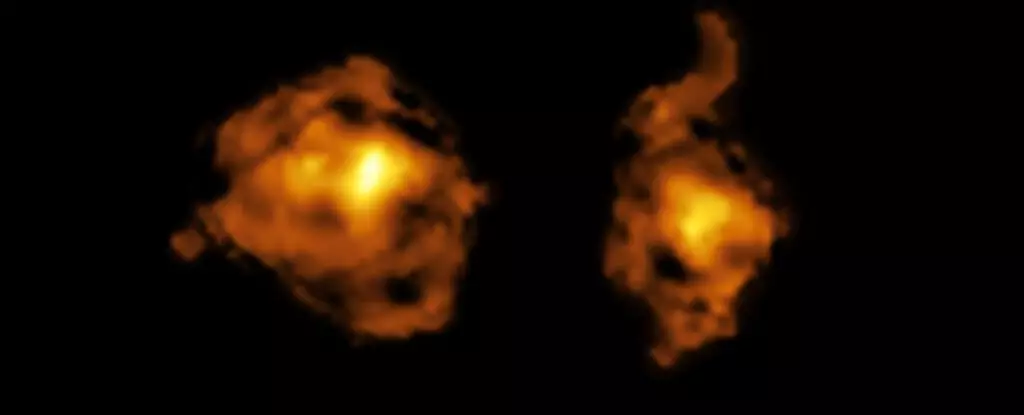In an extraordinary scientific breakthrough, astronomers have witnessed an unprecedented interaction between two galaxies in a dynamic collision far beyond our grasp. This remarkable event is aptly termed the “cosmic joust” — a majestic yet devastating phenomenon arising from the powerful beams of radiation unleashed by a quasar, a highly active supermassive black hole at the center of one of the merging galaxies. This discovery not only sheds light on the mechanics of celestial collisions but poses unsettling implications for star formation in the ‘wounded’ galaxy caught in the crossfire.
The Anatomy of a Galactic Collision
Galaxies are not isolated entities drifting aimlessly through an empty void; rather, they are intertwined in a vast cosmic web sculpted by gravity and dark matter. As galaxies draw closer to one another—lured by the gravitational forces at play—they undergo a mesmerizing dance, swinging around each other in intricate orbits before ultimately merging into larger, more complex structures. Historically, galactic collisions have been a focal point of astrophysical research, illuminating our understanding of both galactic evolution and the growth of the supermassive black holes that reign at their cores.
However, this event stands alone in its explicit display of catastrophic effects during a galactic merging process. This is primarily because one of the galaxies houses a quasar, whose immense energy output can severely disrupt the surrounding space. Instead of a harmonious convergence of cosmic materials, we are presented with a scene where the quasar’s beams of radiation and high-speed jets puncture through the gas and dust of the other galaxy, depleting the very raw materials needed for star creation—an alarming revelation for astrobiology.
The Role of Quasars: Cosmic Powerhouses
Quasars serve as some of the universe’s most powerful beacons, illuminating the dark corners of space with their intense energy. Born from supermassive black holes that feed voraciously on surrounding material, these entities can generate vast jets of radiation and plasma. The quasar’s ability to accelerate and divert charged particles along magnetic field lines creates jets that streak through space at nearly the speed of light. As found in the cosmic joust, this overwhelming force proves to be a disruptive agent in galactic interactions, leaving a trail of destruction that hinders star formation in its wake.
This extraordinary dynamism presents a paradox: while the quasar compels new material towards its core, it simultaneously acts as a destructive force, clearing gas clouds from within the opposed galaxy. Consequently, the cosmic joust reveals how even the colliding galaxies face unique challenges as their essential materials are consumed or ejected into the void. In this relentless cycle, both celestial bodies share an unfortunate fate, redefining our understanding of dual galaxy interactions.
The Aftermath: Possible Outcomes of Galactic Interactions
While the cosmic joust highlights a grim scenario—where one galaxy is suppressed in its star formation attempts—the ensuing interactions can also yield unexpected opportunities for rebirth. Though affected by the quasar’s destructive influence, the galactic collision stirs up turbulence, blending their gaseous reserves and triggering shocks that may foster regions ripe for star formation.
Historically, cosmic clashes have been the precursors to vibrant stellar nurseries; collisions between gas clouds can initiate gravitational collapse, fostering the conditions for new stars to emerge. The process of galactic collisions may thus resemble a phoenix rising from the ashes—where destruction inevitably leads to a cycle of renewal. Such revelations challenge the conventional view that cosmic activity is linear; instead, they underscore the dynamic, often chaotic nature of galactic evolution.
Broader Implications for Astrophysics
The cosmic joust serves as a critical reminder of the complexities within our universe. It compels us to reconsider how we perceive interactions among galaxies, urging us to acknowledge both their destructive and constructive consequences. As astronomers continue to unravel these celestial mysteries, they deepen our appreciation for the intricacies of the cosmos and our search for life beyond Earth.
Every new discovery, particularly one as profound as the cosmic joust, nudges the needle closer to answering the age-old questions surrounding existence, evolution, and the boundless potential of the universe. Such phenomena reveal that cosmic evolution is not merely a story of creation or destruction; it is a grand narrative where the accidents of time and gravity give rise to both chaos and beauty.

